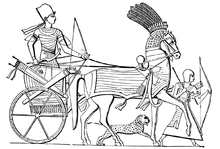User:Dami71/sandbox
INTRODUCTION
The Late Bronze Age war between the New Kingdom of Egypt and the Hittite Empire to the north occurred at a time when Pharaoh Ramesses II sought to reestablish Egyptian influence in its former territory in Syria. Conflict between the two states can be traced as far back as the reign of pharaoh Ahkenaten, who ruled from c. 1353-1336 BCE during the period of Egypt's 18th dynasty. The Hittites, whose capital city Hattusa was located in Anatolia, or modern-day Turkey, had defeated the Babylonian empire in 1595 BCE and had emerged as one of the prominent regional powers of the time. The Anatolian plateau was rich in copper and tin, the metals required to forge the bronze weapons common to the period, and as such, control of well-used trade routes, many of which passed near or through the city of Kadesh, was of vital importance to the Hittites. Ramesses II wished to reclaim imperial lands in Syria that had been lost under previous rulers, and he forged an uneasy alliance with the Mittani Empire that was situated along the Hittites' eastern flank.[1]

THE WAR
The conflict between the two powers reached a climactic point at the Battle of Kadesh in 1274 BCE. Marching north from their homeland, the Egyptian army under Ramesses II numbered an estimated 20,000 men split into four divisions, each named for an Egyptian god, and was accompanied by a large number of two-man war chariots. At Kadesh, which had been fortified against attack by the Hittite King Muwatalli II, Ramesses sought to claim a decisive victory that would drive the Hittites from the Egyptian border. A victory at Kadesh would allow him to seize control of the city and its valuable trade routes and would serve to restore Egyptian influence in Syria that had been lost under his father Seti I. To oppose Ramesses II, Muwatalli II mustered a force of an estimated 37,000 foot soldiers and 3500 three-man war chariots composed of Hittite troops as well as men from a number of his regional allies.[1] The three-man vehicles were heavier than their Egyptian counterparts, and Muwatalli used them to conduct a surprise attack on Ramesses II's vanguard. "The Hittites were known to be highly skilled in chariot-based combat,"[2] and their superior numbers provided an advantage to Muwatalli II that he sought to use to achieve a quick victory over the pharaoh and to drive Ramesses II out of Syria.

The ensuing battle, which occurred along the banks of the Orontes River and is often referred to as the largest chariot battle in history, is the "earliest battle in recorded history for which details of tactics and formations are known."[3] Hittite spies captured by the Egyptians had misled Ramesses II by informing him that the Hittite army was further away than it actually was. As a result, Ramesses II chose to split his forces, leading one of his four divisions ahead of the others and arriving at the battlefield severely outnumbered. Believing his foes to be too far away to intervene, he set up camp and waited for the arrival of the remainder of his army. Muwatalli II, who was aware of the Egyptian presence, sortied forth in an attempt to ambush the opposing army, but the timely arrival of Egyptian reinforcements prevented him from routing the Egyptian forces. The battle was an indecisive encounter that almost certainly ended in a draw. Muwatalli II maintained control of the city, but Ramesses II had managed to avoid being defeated in open battle: a situation that allowed both leaders to claim victory. The Egyptian account of the battle, which portrays Ramesses II as the clear winner, is recorded in the Poem of Pentaur, and Ramesses commemorated the war with panoramic war scenes on several temples including the Hypostyle hall.[4][5]

SUMMARY
The war between the New Kingdom of Egypt and the Hittite Empire stands out in history for several reasons, with the Battle of Kadesh prominent among them. The engagement represents the best preserved remaining recording of an ancient battle discovered up to 30 March 2021, and is commonly viewed as the largest chariot battle in history. Though the encounter was indecisive and both the Hittites and the Egyptians claimed victory, it was influential in the signing of the first peace treaty in 1258 BCE, the earliest recorded peace treaty to be discovered as of 30 March 2021. The battle occurred before the Late Bronze Age collapse, an event that witnessed the downfall of the Hittites, the Minoan civilization, the new Babylonian Empire, which had been ruled by the Kassites since c. 1595 BCE, and Mycenaean Greece and left the New Kingdom of Egypt battered and significantly weakened. What caused the collapse is still a matter of debate, with much attention paid to the enigmatic Sea Peoples, a confederacy of naval raiders who harried the coastal towns and cities of the Mediterranean region between c. 1276-1178 BCE.[6] Other possible causes include climatic changes that could have affected Palatial centers that were dependent upon high levels of agricultural productivity[7]. One crucial problem was the disruption of trade that cut off the supply of tin for alloying with copper to make bronze.[8] As a result of the collapse c. 1200 BCE, the prosperity of the previous two millenia came to an end over the course of the next two hundred years.[9] Though the Egyptian Empire survived the invasion, the Hittite state suffered a complete collapse and never fully recovered.
- ^ https://www.ancient.eu/article/78/the-battle-of-kadesh--the-first-peace-treaty/
- ^ stmuhistory.org/the-battle-with-no-winner-the-battle-of-kadesh/
- ^ military.wikia.org/wiki/Battle_of_Kadesh
- ^ https://www.memphis.edu/hypostyle/tour_hall/ramesses_ii_scenes.php
- ^ www.nationalgeographic.co.uk/history-and-civilization/2020/05/hittites-fast-war-chariots-threatened-mighty-egypt
- ^ https://www.ancient.eu/Sea_Peoples/
- ^ https://www.sciencedirect.com/science/article/abs/pii/S0305440312000416
- ^ https://www.sjsu.edu/faculty/watkins/seapeoples.htm
- ^ citation needed

